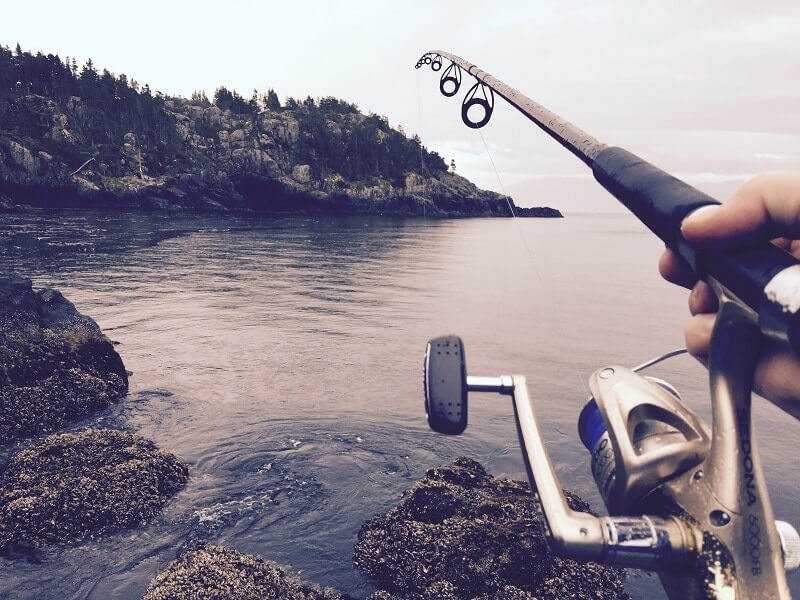Are you searching the internet for learning what is fly fishing backing? Well then, this article is just for you. In this article, we have explained in details what is fly fishing backing.
Let me clear out one thing. We have seen most people get confused about this and we don’t want you to be in the same situation: The fly fishing backing and fly line backing are basically the same things.
Enough introduction, let’s get to the good stuff now.

Some of The Best Fly Fishing Lines For You
Table could not be displayed.
What is a Fly Line Backing?
Fly line backing is a thin but very strong and secured line which is used to hook up the big and strong fishes. For example, some strong fish species like steelhead, tarpon, permit, and bonefish can run long distances within a very short time.
According to research, these species can run up to 200 yards when they are stuck in the fly angler whereas most ordinary fly lines hardly cover 100 yards. So it’s very important to use a good backing on the fly reel for catching the big fishes.
What Is Backing Made Of?

Basically, backing comes in two different materials, gel-spun or Dacron. The Dacron backing is made from a sturdy polyester material which is known as PETE (Polyethylene terephthalate). This material is a synthetic resin which was improved for using in common plastics.
Dacron
From soda bottles to spinnaker sails, the Polyethylene terephthalate is used everywhere. Dacron backings are designed to be spooled in long stands in order to make a hard synthetic line which will cause less friction.
Dacron backings are popular and most widely used. They are available in 20-30 pounds test rating which is a suitable backing for most types of fly fishing.
Gel-Spun

Here comes another one that is gaining popularity and appearing as a competitor to the Dacron backing, the Gel-Spun backing. This baking is made of a polymer material which is called HMPE (High Modulus polyethylene).
This material was developed to be used in body armors, high-performance sailing line, and safe climbing ropes. The way this gel-spun backing is gaining popularity, soon it will overtake the Dacron backing.
Why are people loving this one? Obviously, there is a valid reason that is attracting the fly fishers towards it. Gel-spun backings are highly-durable and 75% more capable than the Dacron backings. They provide better result while catching the big fishes in the ocean.
Why is Backing So Important?
You can get away without backing but there are some benefits of backing which we thought you wouldn’t want to miss. Here are the benefits of having a good fly fishing backing:
For Filling the Reel
You will need a fly line backing to fill the extra space on the fishing reel. Moreover, with the backing, you will be able to reel the line faster. Having a fly line without backing will cost you a lot of time to reel the line.
Hooking Hog
Backing plays a big role in hooking large fish. For hooking a large fish perfectly, you’ll need to let it run. Without a fly fishing backing, the fish wouldn’t be able to run any longer than the fly line length.
As fly lines are very expensive, if somehow the fish pull out all of the lines, then you’ll have to suffer a big loss, which won’t happen if you have a backing.
We have seen this happened to a lot of people, so make sure it doesn’t happen to you too.

Are you Choosing the Right Backing?
In order to get the optimum benefit, you’ll have to get the right backing. The right backing will make a huge difference in your fly fishing. There are several factors that will ensure the backing quality such as, thickness, color, material and breaking strain. Let’s take a look at them:
Is Thicker Backing Better?
You can put a thinner line on the reel which will help you with the fish running case as thicker lines will take extra space on the reel. There are some Gel-Spun lines that are very thin and also have outstanding strength, though these lines are a little bit expensive.
Is your budget tight? Don’t worry, there is another option for you: The Dacron backing. But Dacron lines are thicker which means you will be able to put less amount of line on the reel.
Dacron backings are not recommended for bigger fish. They work great for fishes that wouldn’t run more than 100 yards when fighting with the hook. in the Dacron backing box, you will see an instruction about how much backing they are able to hold.
How Much Sturdiness is OK?
Ending up with a broken backing while lifting up the heavy fishes is the last thing you would want. Sturdiness actually depends on your target fish species. If you are going to hunt down fishes that weight more than 20 kg, you’ll have to choose a backing with high sturdiness.
On the other hand, if you are after small to medium size fish species, an ordinary backing will work. However, choosing the backing with the highest strain strength would be a wise decision. Because, if a big fish gets hooked unexpectedly, you will be able to lift it up.
Does the Color have Any Added Benefit?
No, backing comes in various colors but there are no benefits of choosing one color over another. But one thing that can come in handy is putting a length mark on the line. You can do it with a waterproof marker so that you will know how far the fish is running and how many lines are left.
Which Backing Line Material is the Best?
In the past, backing lines were made of some specific materials but now various types of materials are used to make fly fishing backing. If you are looking for a cheap option, you can go for plain braided monofilament backing but they are heavy.
The Dacron line backings are slightly thinner than the plain braided monofilament. If you want the best backing line, get the Gel-Spun one. However, keep in mind that they are expensive.
Though the Gel-Spun backing line is expensive, it is totally worth the money especially if you are targeting large fish species. For smaller species, Dacron or plain braided monofilament will work fine.
How Many Backings Should You Put On the Reel?
There is no exact number. You can have as much as your fly reel can hold. However, never load such an amount of line that will touch the reel stand. If it touches the reel stand, it can create trouble in different ways. Plus, when the line continuously touches the reel stand, it will create friction which will damage the line.
Below we have given some approximations depending on the fish species, have a look:
- For small panfish or trout, you will need 20 to 50 yards of backing.
- For middle-sized trout, 50 to 100 yards of backing is enough.
- Large steelhead or trout will need more than 150-yard backing.
- For big salmon, you will need at least 250 yards of backing.
- Large carp and bonefish will need more than 250-yard backing.
- For tarpon or big ocean fishes, you would definitely need more than 300-yard backing.
Wrapping Up!
We hope by now you have a clear idea of what is fly fishing backing. We have tried to cover all the information related to fly fishing backing in this article. By following the tips mentioned here, you’ll definitely get better at fly fishing.

